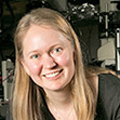 |
| SPIE Women in Optics 18-month planner for 2016-2017. |
- exploring photonic nanostructures that can improve the efficiency of solar energy generation
- observing micro-organisms in the Arctic ice to learn more about lifeforms of all sorts
- developing optical systems for noninvasive diagnosis of tumors inside the body
- assessing the radiation hazard to be incurred by humans travelling to the Moon, Mars, and beyond.
The paths to all careers include some challenges. For anyone
looking at a career in STEM, the latest edition of a free annual publication offering
insights on those paths has just been released.
The 12th edition of the Women in Optics Planner published by
SPIE contains more insights from more than 30 women discussing their interests
and occupations and offering advice. Among their stories:
 |
| Viera-Gonzalez |
Her biggest career obstacle is “swimming upstream and (meeting)
resistance to change. I sometimes encounter people who prefer to always do
things the same way. The solution? I never give up. Believe in yourself. Try
new ideas, and if you fail, learn from that. Improve and carry on.”
Viera-Gonzalez shares her inspiration and passion with her
community, organizing STEM conferences for students, workshops for kids, basic
education for teachers, science fairs, and other events, with support from SPIE
and her university.
 |
| Mikkelsen |
Now she leads a research group exploring the behavior of
novel nanoscale structures and materials by studying their interaction with
laser light, which may lay the foundation for future quantum- or nano-based
technologies. Her advice? “Follow your heart and do what you love!”
 |
| Lukishova |
As an undergrad, she followed the advice of a professor to
select the strongest research group with an outstanding leader and ended up
carrying out her master’s and PhD research under Nobel Laureate Alexander Prokhorov.
As a working professional, she says, her biggest obstacle is
that she is “too modest. In a competitive environment, it is necessary to
defend your rights.” She advises young girls “to set the highest goals in your
life and your scientific and engineering career; work hard, but with
inspiration; and don’t forget that you are women.”
 |
| James Asirvatham |
As a research associate at Lancaster University, Asirvatham explores
novel photonic nanostructures to improve the efficiency and economy of solar
energy production. "STEM is for creative thinkers," she says. "Choosing
a career in STEM will provide lifelong professional development.”
 |
| Greenwood |
"Sometimes it's impossible not to feel discouraged, but
stay strong and believe in yourself. Use fear as fuel for action," she
says.
Greenwood oversees an MRI-based prostate cancer clinical
trial, delivering laser interstitial thermal therapy to prostate cancer using
thermal mapping with MRI.
 |
| Wang |
Do not to be afraid of difficulties and mistakes, Wang advises.
"Facing these can make you stronger."
All the stories are available online; copies of the planner
are free for the asking via the same link.
Thanks to all for the inspiration!

Comments
Post a Comment